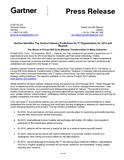.2012 – Gartner, Inc. has revealed its top industry predictions for IT organisations and users for 2013 and beyond. Analysts said that social networking, mobile communications, the cloud and information are pressuring enterprises worldwide to make fundamental changes in business processes and that industry decision-makers should use Gartner-s predictions to understand and respond to this Nexus of Forces.
Gartner-s annual Predicts research on industry trends titled “Top Industry Predicts 2013: The Nexus of Forces Will Drive Massive Transformation in Many Industries,” features 14 strategic planning assumptions that CIOs, senior business executives and IT leaders should factor into their enterprise planning and strategy-setting initiatives. The report is available on the Gartner Predicts 2013 website, www.gartner.com/predicts.
“Most industries will face massive changes during the period from 2013 through 2015. These changes will force fundamental shifts in business processes that will, in turn, further reshape those industries,” said Kimberly Harris-Ferrante, vice president and distinguished analyst at Gartner. “The social commons, mobile communications, cloud computing and information will be especially important factors in driving even greater industry transformation, challenging existing business models and processes and opening up greater competitive and other threats.”
CIOs and other IT and business leaders can use Gartner-s predictions and recommendations to better understand the forces that are changing their world and develop strategies to address the requirements of a fast-changing business environment. The top industry predictions include:
By 2016, three automakers will have announced concrete plans for upcoming automobile launches that will offer autonomous vehicle technology.
By 2015, nontraditional money creation and exchange will enable 125 million more people to participate in the mainstream global economy.
By 2016, patients will be harmed or placed at risk by a medical device security breach.
By 2016, national governments will require institutions to surrender student records for a redesigned, cost-cutting curriculum based on big data analysis.
By 2015, natural-language processing (NLP) use among large healthcare delivery organisations (HDOs) in English-speaking countries will quintuple, fuelled by documentation, coding, quality reporting and research.
By 2015, to avoid becoming simply transaction factories, successful payer organisations will turn to information integration as their competitive differentiator.
By 2016, half of U.S. utility customers will have access to standardised energy usage data, but only 20 per cent will use it.
By year end 2014, pay-as-you-drive insurance will rise significantly to account for 10 per cent of overall annual auto insurance premiums.
By 2017, more than 50 per cent of the media sold to advertisers by agencies will be priced based on performance.
By 2014, less than 2 per cent of consumers globally will adopt Near Field Communication (NFC)-based mobile payments.
More than 50 per cent of government shared-service organisations that provide cloud services by 2015 will discontinue or downscale them by 2017.
By 2015, 50 per cent of Tier 1 consumer goods manufacturers will invest in technology start-ups to maintain access to emerging business-to-consumer (B2C) technology.
Through 2014 enterprise software spend will increase by 25 per cent from current figures as a consequence of the proliferation of smart operational technology (OT).
By 2016, at least 25 per cent of discrete manufacturers will adopt 3D printing to produce parts for products they sell or service.
“Many of the Nexus of Forces direct and indirect impacts, such as the need to respond to the pervasiveness of social networking and the mobile-device-driven consumerisation of IT, are being felt across virtually all industries,” said Ms. Harris-Ferrante. “Others, including intensifying regulatory requirements, resulting in part from increasing reliance on cloud computing and other -open- IT delivery models, are industry-specific. But all these forces, and the changes in business processes they demand, present enterprise IT and business decision-makers with an extraordinarily difficult set of choices in the years to come.”
Additional information is in the Gartner Predicts Special Report that is available on Gartner-s website at www.gartner.com/predicts. Gartner analysts will provide further analysis during the complimentary webinar “Top Technology Predictions for 2013 and Beyond” today at 1 p.m. GMT and 4 p.m. GMT. To register for the webinar, please visit http://my.gartner.com/portal/server.pt?open=512&objID=202&mode=2&PageID=5553&resId=2232827&ref=Webinar-Calendar.
Gartner, Inc. (NYSE: IT) is the world-s leading information technology research and advisory company. Gartner delivers the technology-related insight necessary for its clients to make the right decisions, every day. From CIOs and senior IT leaders in corporations and government agencies, to business leaders in high-tech and telecom enterprises and professional services firms, to technology investors, Gartner is a valuable partner in 12,400 distinct organisations. Through the resources of Gartner Research, Gartner Executive Programs, Gartner Consulting and Gartner Events, Gartner works with every client to research, analyze and interpret the business of IT within the context of their individual role. Founded in 1979, Gartner is headquartered in Stamford, Connecticut, USA, and has 5,300 associates, including 1,390 research analysts and consultants, and clients in 85 countries. For more information, visit www.gartner.com.


You must be logged in to post a comment Login